Physical Address
304 North Cardinal St.
Dorchester Center, MA 02124
The findings and conclusions in this work are those of the author and do not necessarily represent the official position of the Centers for Disease Control and Prevention.
Infections of the central nervous system (CNS) are usually associated with tremendous clinical significance. Because of the unique anatomic structure and physiologic functions of the CNS, even mild neurologic damage caused by infectious processes can produce serious consequences with a potential fatal outcome. Based on the involved anatomic structures, CNS infections are generally classified as meningitis, encephalitis, or myelitis; although bacterial infections usually cause meningitis, viral infections often involve multiple structures and produce meningoencephalitis, encephalomyelitis, or meningoencephalomyelitis. A common semantic practice is to apply the term encephalitis to describe these viral infections collectively. A great number of viruses have tropism for the neural tissues and account for serious acute encephalitis ( Table 7-1 ). Viral encephalitis can be further divided into three categories based on pathogenesis: (1) diseases resulting from human-to-human transmission or decreased immunity (encephalitis caused by herpesviruses, enterovirus 71, etc.); (2) zoonotic diseases acquired by direct contact with an animal (encephalitis caused by rabies virus, Nipah virus, etc.); and (3) diseases acquired from an insect arthropod vector (encephalitis caused by West Nile virus, eastern equine encephalitis virus, etc.). This chapter focuses on diseases in category 3, whereas diseases in categories 1 and 2 are discussed in other chapters covering the specific etiologic agents.
| Togaviridae | Herpesviridae |
|---|---|
| Alphavirus Eastern equine (EEE) —Western equine (WEE) —Venezuelan equine (VEE) |
Herpes simplex virus (HSV) Varicella-zoster virus (VZV) Cytomegalovirus (CMV) Human herpesvirus 6 (HHV6) Herpes B virus |
| Flaviviridae | Reoviridae |
| St. Louis (SLE) Japanese (JE) Murray Valley (MVE) West Nile (WNE) Tick-borne complex |
Colorado tick fever (CTF) |
| Bunyaviridae | Rhabdoviridae |
| La Crosse (LCE) Rift Valley (RVF) Toscana |
Rabies Lyssavirus |
| Arenaviridae | Adenoviridae |
| Lymphocytic choriomeningitis Lassa Machupo Junin |
Adenovirus |
| Filoviridae | Paramyxoviridae |
| Ebola Marburg |
Paramyxovirus —Mumps Morbillivirus Measles Henipavirus —Hendra virus —Nipah virus |
| Retroviridae | Picornaviridae |
| Human immunodeficiency (HIV) | Enterovirus Poliovirus Coxsackievirus Echovirus EV71 |
| Papovaviridae | |
| Polyomavirus JC virus |
Viral encephalitis can occur sporadically or in epidemics, either in particular geographic areas or with a worldwide distribution. Viruses can infect individuals of all ages from neonates to the elderly, but some viruses favor particular age groups. There are many possible entry pathways of viral agents into the CNS, such as hematogenous spread, respiratory inhalation, the oral route, or cutaneous inoculation. Most viruses reach the nervous system via the bloodstream during a temporary phase of viremia after replication in infected distant organs. Some viruses, such as rabies virus and herpes zoster virus, may reach the CNS along peripheral nerves through a retrograde axonal transport.
The manifestations of viral encephalitis are remarkably diverse, ranging from asymptomatic or mild illness to fatal infection. The signs and symptoms of the different categories of encephalitis are usually similar and cannot be clinically differentiated. Common manifestations include fever, headache, nuchal rigidity, mental status changes, sensory or motor deficits, and seizures. Clinical diagnosis of viral encephalitis is often challenging because of the anatomic and physiologic obstacles of the brain and spinal cord, including their unique immunologic surveillance system and the blood-brain barrier. Although clinical manifestations, patient history, and physical examination can suggest a possible diagnosis of viral encephalitis, they are often unreliable for determining the actual pathologic process given that other noninfectious diseases can present with similar clinical manifestations. Electroencephalography (EEG), magnetic resonance imaging (MRI), and computerized axial tomography (CAT) scans may provide anatomic and dimensional information of the lesions to suggest the areas of CNS involvement, but their sensitivity and specificity vary widely among different encephalitides, as well as severity and stages of the illness. Routine laboratory studies, including complete blood counts, biochemical assays, and cerebrospinal fluid (CSF) examination, show mostly nonspecific findings. Furthermore, these laboratory test results may not represent the actual disease process because of the lack of clinicopathologic correlation. In contrast, if neural tissue samples are available, pathologic examination with pertinent testing including immunohistochemistry and polymerase chain reaction (PCR) can provide a more accurate diagnosis, as well as insight for understanding the pathogenesis of viral infections.
The histopathologic features in viral encephalitis correlate with the properties of the infecting virus, the host immune responses, and the topographic areas of involvement. Once the virus reaches the brain parenchyma, a widely disseminated infection of neurons and glia cells may ensue. This will provoke an acute immune response with inflammatory cell infiltration into the perivascular space ( Figure 7-1 A), parenchyma ( Figure 7-1 B), and leptomeninges ( Figure 7-1 C). The degree of inflammation varies; typically lymphocytes predominate with more T cells and fewer B cells. Some viral infections may be associated with more abundant polymorphonuclear cells, especially during the acute phase ( Figure 7-2 ). Vascular involvement with inflammatory cells can be seen in some viral infections, such as Nipah virus ( Figure 7-3 ) or human herpes viruses. The infected neurons are surrounded by clusters of inflammatory cells, activated microglial cells, and macrophages with phagocytic activities (neuronophagia; Figure 7-4 ). The diseased neurons gradually disintegrate (neuronal necrosis; Figure 7-5 ). Eventually, residual microglial nodules replace the destroyed neurons (microglial nodules; Figure 7-6 ). Neuronal necrosis and lysis of glial cells result in cerebral edema and loss of neurologic functions. Gray matter is usually more involved than white matter in most acute viral infections. Focal areas of parenchymal hemorrhage are commonly seen in viral encephalitis. Although immune responses will eventually terminate the infection, the damage is often irreversible and the patient may be left with permanent neurologic sequelae or progress to death. Most acute viral CNS infection results in nonspecific histopathologic findings as described earlier, such as perivascular cuffing, parenchymal and meningeal inflammation, neuronal necrosis, neuronophagia, microglial nodule, and reactive gliosis. However, aggregates of viral particles may form inclusion bodies in the nucleus or cytoplasm of infected neurons and glial cells in some viral infections. These intranuclear or intracytoplasmic inclusion bodies are helpful for etiologic diagnosis ( Table 7-2 ; Figures 7-7 through 7-12 ). For instance, the presence of Negri bodies in the hippocampus and cerebellum are pathognomonic of rabies virus infection (see Figure 7-7 ), whereas Cowdry type A inclusions with hemorrhagic necrosis in the temporal lobe are commonly associated with human herpes simplex virus infections (see Figure 7-8 ). Unfortunately, these helpful morphologic features are not observed in other more common viral encephalitides, such as those caused by enteroviruses and arboviruses. Therefore, more specific tests are required for a definitive etiologic diagnosis.
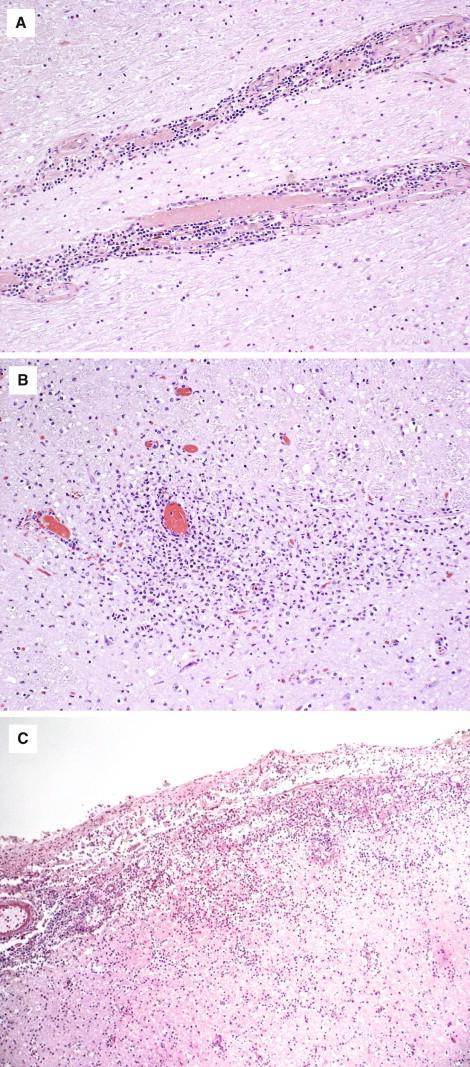
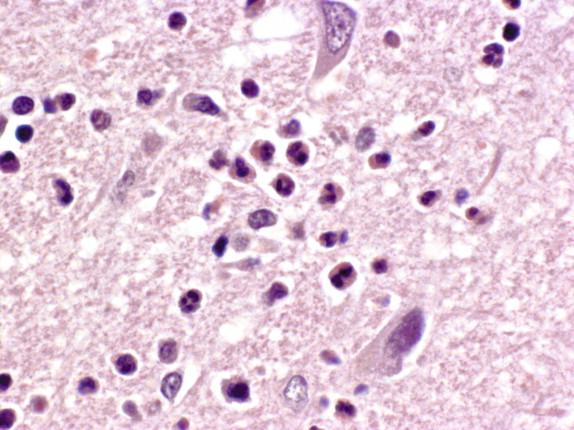
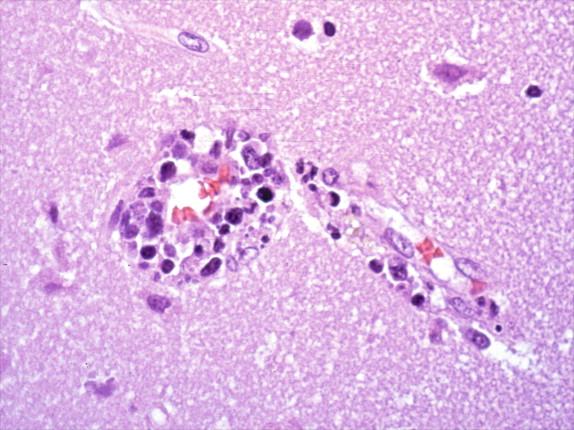
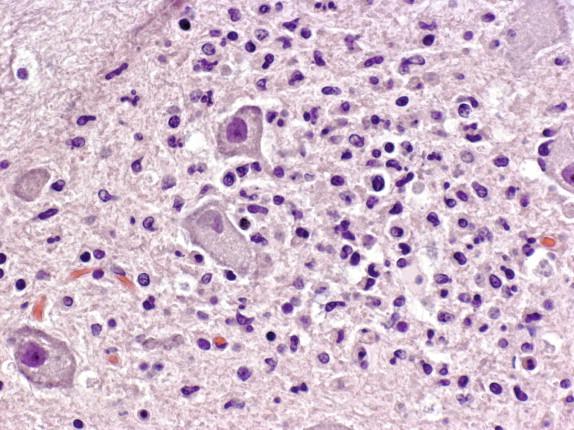
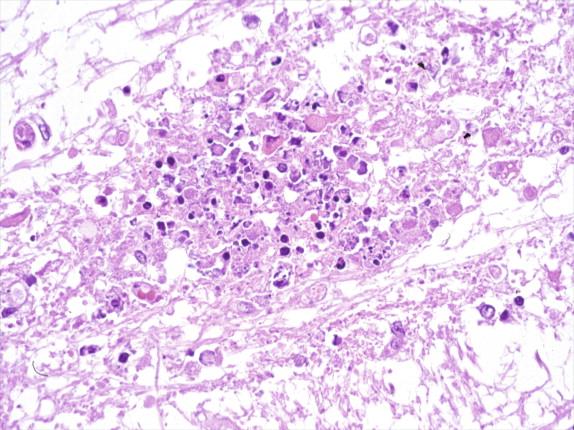
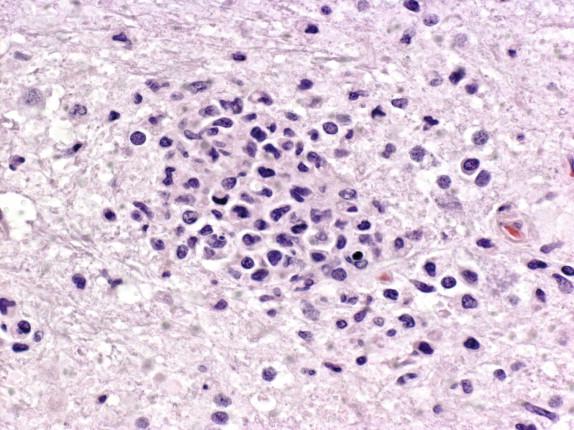
| Virus | Inclusions | Description |
|---|---|---|
| Adenovirus | Smudge cell (see Figure 7-11 ) Cowdry type A intranuclear |
Moderately enlarged nucleus and indistinct nuclear membrane Amphophilic or basophilic inclusion surrounded by a halo and by marginated unbeaded chromatin |
| Cytomegalovirus (CMV) | Cowdry type A intranuclear
Intracytoplasmic |
Amphophilic or basophilic inclusion surrounded by a halo and by marginated unbeaded chromatin Inclusion consists of clusters of small granular, basophilic bodies of various sizes |
| Herpes simplex virus | Cowdry type A intranuclear (see Figure 7-8 ) | Amphophilic to eosinophilic inclusion surrounded by a halo and by marginated beaded chromatin |
| Varicella zoster virus | Cowdry type A intranuclear | Amphophilic or basophilic inclusion surrounded by a halo and by marginated unbeaded chromatin |
| Rubeola (measles) virus | Warthin-Finkeldey cells Intranuclear (see Figure 7-9 ) Intracytoplasmic (see Figure 7-9 ) |
Syncytial giant cells with inclusion bodies Round or lobulated, hyalinized, eosinophilic, surrounded by halo Eosinophilic and vary in size |
| Rabies virus | Negri body (intracytoplasmic) (see Figure 7-7 ) | Round to oval, eosinophilic, inclusion in Purkinje cells of cerebellum and large neurons of hippocampus |
| JC polyomavirus | Intranuclear (see Figure 7-12 ) | Single or multiple small hyalinized eosinophilic to amphophilic inclusion |
| Nipah virus | Intranuclear Intracytoplasmic (see Figure 7-10 ) Syncytial or multinucleated giant cell formation |
Eosinophilic inclusion with a thin rim of chromatin at the periphery Eosinophilic inclusion in neurons Endothelium and epithelial cells |
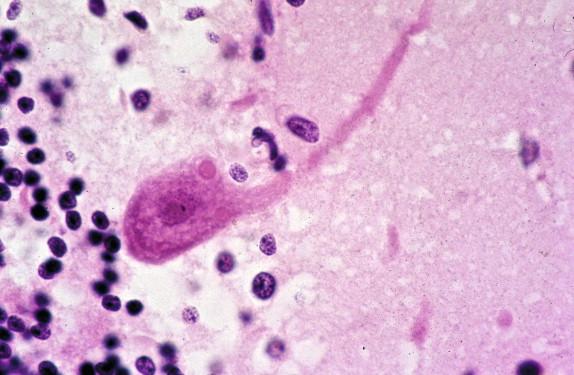
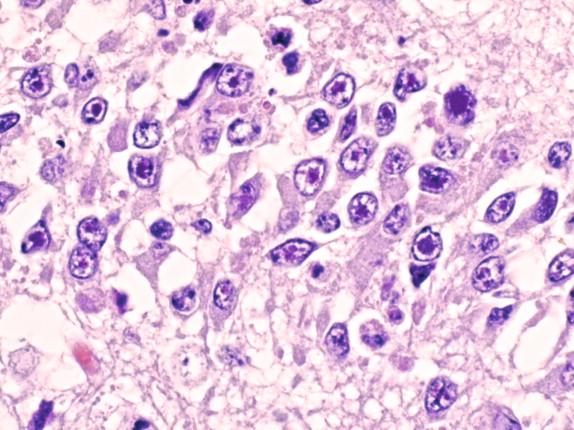
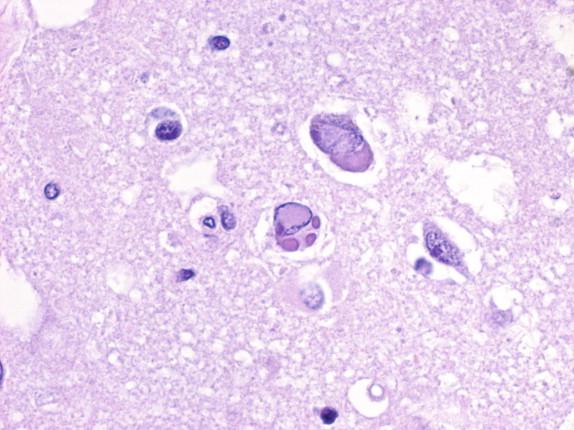
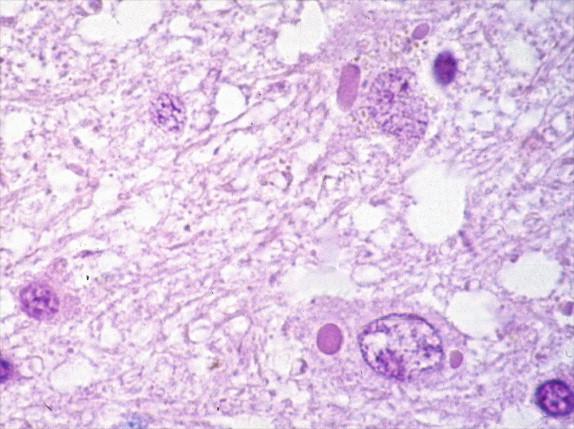
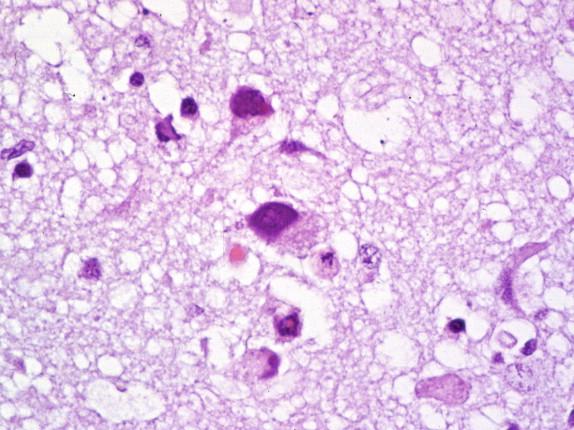
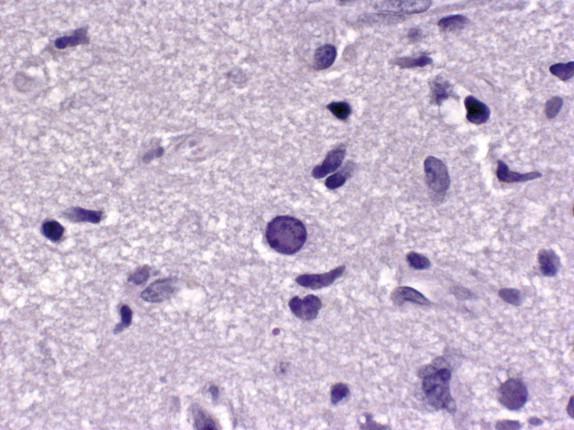
Arboviral encephalitis is caused by viruses in the Arbovirus group. The term arbovirus stands for Arthropod-borne virus because these viruses are passed to humans by members of the phylum Arthropoda, mostly ticks and mosquitoes. The arbovirus group is not a taxonomic group based on genetic relatedness but is instead a functional group based on a similar pathway of transmission. Some common features are shared by a variety of arbovirus encephalitides: (1) they are the most common causes of encephalitis epidemics in specific geographic areas; (2) the diseases are acquired by mosquito or tick bites, more frequently in summer or early fall; (3) avian species or small mammals are commonly involved as intermediate hosts in the transmission cycle; (4) the viruses reach the nervous tissue through the bloodstream from the site of inoculation, inducing subsequent CNS infection; (5) the prognosis varies but usually is more serious among children, the elderly, and immunocompromised individuals.
There are a large number of arboviruses, and about 80 types are known to be human pathogens. In addition to the virus, intermediate hosts, such as avian species or small mammals, are usually involved in the cycle leading to human diseases. The viruses are passed to the intermediate hosts when the arthropod harboring the viruses attempts to feed on the blood of these hosts. The virus may or may not cause illness in the new intermediate host and will start replicating if the new host survives the infection. Eventually, the tick or mosquito bites humans or other animals, such as horses, and transmits the virus to these end hosts. A few types of arbovirus cycles only exist between arthropods and humans with no intermediate hosts involved. Because the arboviruses require an arthropod vector to pass them to humans, the most common seasons of year for these illnesses are summer and early fall, when mosquitoes and ticks are most prevalent. Geographic locations, climatic conditions, and environmental factors also play crucial roles in the epidemiology of arbovirus infections. For instance, tropical and subtropical areas with warm and humid environments favor propagation of mosquitoes, thus increasing the risk of arbovirus infections.
The major etiologic agents of arboviral encephalitis include the members of the viral families Togaviridae (causing eastern equine encephalitis, western equine encephalitis, and Venezuelan equine encephalitis), Flaviviridae (causing West Nile encephalitis, St. Louis encephalitis, Japanese encephalitis, tick-borne encephalitis, Murray Valley encephalitis, Russian spring-summer encephalitis, and Powassan encephalitis), Bunyaviridae (causing California group encephalitis), and Reoviridae (causing Colorado tick fever). In the United States, the most important types of arboviral encephalitis include eastern equine encephalitis (EEE), western equine encephalitis (WEE), West Nile encephalitis (WNE), St. Louis encephalitis (SLE), Powassan encephalitis (PE), La Crosse encephalitis (LCE), and Colorado tick fever (CTF). Powassan encephalitis virus and CTF virus are transmitted by ticks; all other arboviral encephalitides endemic in the United States are transmitted by mosquitoes.
After a bite by an infected arthropod, viral replication occurs in local tissues and regional lymph nodes. Viremia then ensues and can persist for various periods of time, depending on the extent of viral replication in extraneural sites and the rate of viral clearance. Viral clearance can be achieved by actions of host defensive mechanisms, including the mononuclear phagocytic system, cytotoxicity cellular responses, and production of humoral antibodies. The neural parenchyma may be invaded during the viremic stage, but the mode of invasion of virus across the blood-brain barrier is not completely understood. The immature brain is more susceptible to damage by WEE, Venezuelan equine encephalitis (VEE), and La Crosse encephalitis (LCE) viruses, therefore more severe cases of these viral encephalitides are seen in younger children. In contrast, SLE and WNE viruses predominantly affect the elderly, whereas Japanese encephalitis (JE) and EEE occur with a bimodal incidence and cause higher morbidity and mortality in both children and elderly individuals. Immunocompromised or immunosuppressed patients are also more likely to have severe outcomes of arboviral encephalitis.
Diagnosis of arbovirus infection depends on carefully obtaining a history, including exposure to intermediate hosts and arthropod vectors, the patient’s age, season of disease occurrence, residential area, travel, and outdoor activity. Laboratory confirmation of infection is essential. The virus may be isolated from acute phase serum or whole blood in tissue culture. Serologic testing with neutralization, complement fixation (CF), hemagglutination inhibition (HI), fluorescent antibody (FA), and enzyme-linked immunosorbent assay (ELISA) of acute and convalescent sera may help establish the diagnosis. Sensitive nucleic amplification assays using reverse transcription polymerase chain reaction (RT-PCR) and real-time RT-PCR have been developed for a number of arboviruses and may lead to earlier diagnosis. The Centers for Disease Control and Prevention (CDC) established criteria for the diagnosis of an arboviral encephalitis that require the presence of an acute febrile illness with clinical manifestation of encephalitis during a time when virus transmission is likely plus one of the following criteria: (1) fourfold or greater change in virus-specific serum antibody titer between acute and convalescent sera; (2) isolation of virus from or demonstration of specific viral antigen or genomic sequences in tissue, blood, cerebrospinal fluid (CSF), or other body fluid; (3) virus-specific immunoglobulin M (IgM) antibodies demonstrated in CSF by antibody-capture enzyme immunoassay (EIA); or (4) virus-specific-IgM antibodies demonstrated in serum by antibody-capture EIA and confirmed by demonstration of virus-specific serum immunoglobulin G (IgG) antibodies in the same or a later specimen with another serologic assay.
Although serologic confirmation remains the gold standard for diagnosis of arboviral infections, molecular tests are important for identifying early infection prior to seroconversion, infected transplant tissues, and blood, and for confirming the diagnosis. Several assays using traditional RT-PCR, nested RT-PCR, and TaqMan probe-based real-time RT-PCR have been developed to identify arboviral infections. Primer probe sets used in these tests can be used for the universal detection of all Flaviviruses or may be virus specific. Studies by the CDC (Division of Vector-Borne Infectious Diseases, Fort Collins, Colorado) have well defined the status of molecular testing for arboviral infections in both humans and surveillance populations, including vectors, avian species, and other vertebrates. These molecular tests can be performed on fresh tissue samples as well as formalin-fixed paraffin-embedded tissues, making them useful ancillary methods for pathologic diagnosis when tissue samples are available.
Two pathologic processes are common to the arboviral encephalitides: (1) inflammatory responses with migration of immunologically active cells into the perivascular space, meninges, and brain parenchyma and (2) neuronal and glial damage mediated by intracellular viral infection. Vasculitis with endothelial cell swelling and destruction of myelin sheaths in deep white matter areas may be present in some arboviral encephalitides. As mentioned in the overview, histopathologic findings in arbovirus encephalitides are usually nonspecific; therefore other special pathologic methods, such as immunohistochemical (IHC) assay, in situ hybridization (ISH), electron microscopy (EM), or RT-PCR are essential for establishing a specific etiologic diagnosis. IHC assay is especially useful for pathologists as an ancillary diagnostic method. IHC provides several advantages, including the use of formalin-fixed, paraffin-embedded tissues rather than fresh tissues, which can minimize biohazard risks for laboratory personnel, the determination of a more specific diagnosis of an infectious agent, and localization of the virus with cellular or tissue tropism. The results can also provide insightful information for the study of viral pathogenesis.
There are no effective antiviral drugs or specific treatments for arboviral encephalitis. Clinical management is supportive with an emphasis on addressing problems such as increased intracranial pressure, severe hyperthermia, convulsions, loss of the autonomic cardiopulmonary function, and treatable infectious complications such as bacterial pneumonia. There are no commercially available human vaccines for EEE, WEE, SLE, LCE, or other arboviral diseases in the United States. JE vaccines are available in Asian countries, and a tick-borne encephalitis vaccine is available in Europe; however, their efficacy in preventing human infections varies widely. An equine vaccine is available for EEE, WEE, and VEE. There are two major ways to prevent arboviral encephalitis: (1) personal protective measures to minimize direct exposure to infected vectors and (2) public health measures to reduce the population of infected vectors, especially mosquitoes. Personal measures include reducing time outdoors, particularly in early evening hours, wearing long pants and long-sleeved shirts, and applying insect repellent to exposed skin areas. Public health measures often require environmental spraying of insecticides to kill larvae and adult mosquitoes.
The following sections address the most important causes of viral encephalitis worldwide.
The EEE virus is a member of the Alphaviruses in the Togaviridae family, all of which are enveloped, single plus-stranded RNA viruses with icosahedral symmetry. Ultrastructure examination can demonstrate nucleoids within the cytoplasmic matrix and on complex membranous structures ( Figure 7-13 ). The EEE virus was first isolated in 1933 from the brains of horses during an epizootic outbreak of equine encephalitis in Virginia and New Jersey and was subsequently demonstrated to cause human encephalitis in 1938. Birds are the primary reservoir hosts, and many avian species are susceptible to infection. In North America, the primary enzootic cycle is maintained in swamps with the ornithophilic mosquito Culiseta melanura as the vector. Infection with EEE virus occurs focally along the eastern and Gulf coasts of the United States. There are also a few documented cases in southern Canada and the northern areas of South America and the Caribbean. EEE usually occurs in the summertime and most frequently affects children and elderly people. The incidence of equine cases greatly exceeds that in humans, and outbreaks resulting in the deaths of hundreds of horses have been reported in the northeastern United States and Florida. In horses, the infection may involve multiple organ systems, including the CNS, heart, spleen, urinary tract, and gastrointestinal tract. Involvement of extra-CNS organs are rarely observed in fatal human cases.
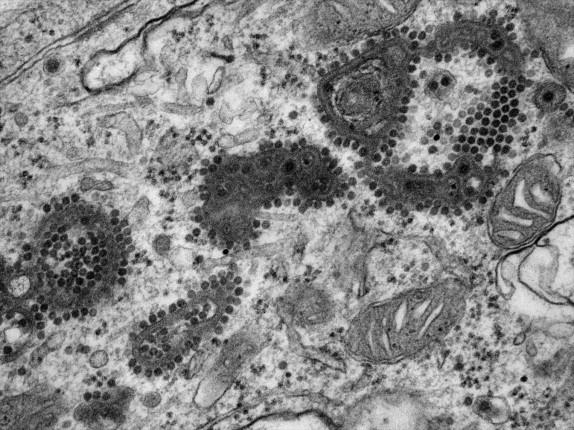
In humans, North American strains of EEE virus are the most virulent of the encephalitic Alphaviruses with high mortality in all age groups. Most cases are associated with exposure to mosquitoes in wooded areas adjacent to swamps and marshes. Children under 10 years of age are most susceptible to a severe outcome, with a fourfold higher incidence of infection resulting in encephalitis compared with adults with infection. There is usually a 5- to 10-day prodrome of EEE virus infection with high fever, chills, headache, nausea, and gastrointestinal disturbances. In patients with CNS involvement, initial symptoms are followed by mental confusion, somnolence, and photophobia. Seizures or convulsions occur most often in younger patients. Progression to frank coma can occur rapidly after CNS involvement. Neurologic examination may reveal neck stiffness, depressed or hyperactive reflexes, muscle twitching, tremors, and spastic paralysis. Bilateral papilledema and cranial nerve palsies can occur secondary to increased intracranial pressure or directly related to inflammation. Cranial nerves VI, VII, and XII are most often affected. Bulging fontanelles may be prominent in infants. Death typically occurs within 2 to 10 days after the onset of encephalitis.
CSF findings are almost always abnormal with increased pressure and protein, and a low or normal glucose level. Red blood cells and xanthochromia are commonly present, whereas white cell counts range from 10 to 2000/dl. Polymorphonuclear leukocytes may be abundant during the early stage of infection, with a subsequent shift to mononuclear cells over the first few days. Serologic testing remains the most commonly used method to confirm the diagnosis, such as demonstration of IgM antibodies in CSF by capture ELISA, demonstration of serum IgM antibodies, or a fourfold increase in IgG antibodies between acute and convalescent sera. Biopsy is rarely performed in living patients with suspected arbovirus encephalitis, but pathologic examination is more commonly performed on fatal cases, particularly those without an etiologic diagnosis of encephalitis.
Encephalitis caused by eastern equine encephalitis virus, a mosquito-borne virus in the genus Alphavirus, family Togaviridae.
Birds are the primary reservoir hosts, and many avian species are susceptible to infection.
In North America, the primary enzootic cycle is maintained in swamps with the ornithophilic mosquito Culiseta melanura as the vector.
EEE virus transmission is most common in and around freshwater hardwood swamps in the Atlantic and Gulf Coast states and the Great Lakes region.
In the United States, an average of six human cases of EEE are reported annually.
Most cases of EEE have been reported from Florida, Georgia, Massachusetts, and New Jersey.
The incidence of equine cases greatly exceeds that in humans.
Children and elderly people are at greatest risk for developing severe disease.
Most cases are associated with exposure to mosquitoes in wooded areas adjacent to swamps and marshes.
Usually a 5- to 10-day prodrome with high fever, chills, headache, nausea, and gastrointestinal disturbances.
Overall, only about 4% to 5% of human EEE virus infections result in EEE.
In patients with CNS involvement, initial symptoms are followed by mental confusion, somnolence, and photophobia.
Seizures or convulsions occur most often in younger patients.
Progression to frank coma can occur rapidly after CNS involvement.
Neurologic examination may reveal neck stiffness, depressed or hyperactive reflexes, muscle twitching, tremors, and spastic paralysis.
Bilateral papilledema and cranial nerve palsies can occur secondary to increased intracranial pressure or directly related to inflammation.
Cranial nerves VI, VII, and XII are most often affected.
Death typically occurs within 2 to 10 days after onset of encephalitis.
Computed tomographic scans may be normal or show only edema.
Magnetic resonance imaging scans are more sensitive to detect abnormalities with focal lesions most commonly observed in the thalamus, basal ganglia, and brainstem.
In general, radiologic findings are nonspecific and cannot establish an etiologic diagnosis.
EEE is usually associated with a high case fatality rate and severe sequelae among survivors.
The case fatality rate is 30% to 40%, with the highest rates in children and the elderly.
Sequelae, including seizures, paralysis, and mental retardation, are common.
A significant proportion (35% to 80%) of survivors, particularly young children, develop long-term neurologic impairment.
There is no effective antiviral drug or specific treatment.
Computed tomographic (CT) scans may be normal or show only edema. Magnetic resonance imaging (MRI) scans are more sensitive for detecting abnormalities, with focal lesions most commonly observed in the thalamus, basal ganglia, and brainstem. In general, radiologic findings are nonspecific and cannot establish an etiologic diagnosis.
EEE causes lesions throughout the brain and spinal cord, most severely involving the cerebral cortex, brainstem, and basal ganglia. The brain may be edematous and show foci of necrosis or hemorrhage.
Histopathologic findings of fatal EEE cases demonstrate a diffuse meningoencephalitis with widespread neuronal destruction, multifocal areas of liquefactive parenchymal necrosis ( Figure 7-14 ), and perivascular cuffing with prominent polymorphonuclear and mononuclear leukocytes ( Figure 7-15 ). Vasculitis with vessel occlusion, perivascular extravasation of red blood cells, and endothelial cell swelling ( Figure 7-16 ) may be seen in fatal cases in humans and experimental animals, especially in areas of the cortex, basal ganglia, and brainstem. Other common findings include neuronal necrosis, neuronophagia, glial nodules, and gliosis. Neuronal necrosis is marked by cytoplasmic swelling and nuclear pyknosis ( Figure 7-17 ). Apoptotic glial and inflammatory cells are frequently observed in the regions of infected neurons.
CSF is almost always abnormal with increased pressure and protein, and a low or normal glucose level.
CSF white cell counts range from 10 to 2000/dl; polymorphonuclear leukocytes may be abundant at early stages with a shift to mononuclear cells over the first few days.
Serologic testing remains the most commonly used method to confirm the diagnosis.
EEE causes lesions throughout the brain and spinal cord, most severely involving the cerebral cortex, brainstem, and basal ganglia.
Gross findings are usually nonspecific; the brain may be edematous and show foci of necrosis or hemorrhage.
Histopathologic findings demonstrate a diffuse meningoencephalitis with widespread neuronal destruction, multifocal areas of liquefactive parenchymal necrosis, and perivascular cuffing with prominent polymorphonuclear and mononuclear leukocytes.
Vasculitis with vessel occlusion, perivascular extravasation of red blood cells, and endothelial cell swelling may be seen, especially in areas of cortex, basal ganglia, and brainstem.
Other common histopathologic findings include neuronal necrosis, neuronophagia, glial nodules, and gliosis.
Neuronal necrosis is marked by cytoplasmic swelling and nuclear pyknosis.
Apoptotic glial and inflammatory cells are frequently observed in the regions of infected neurons.
IHC demonstrates viral antigens in neurons, neuronal processes, and areas of parenchymal necrosis.
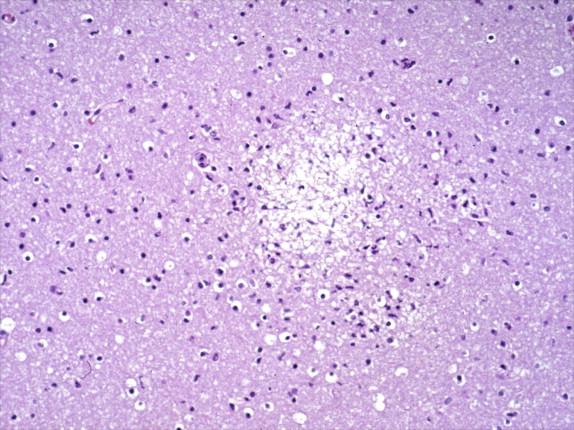
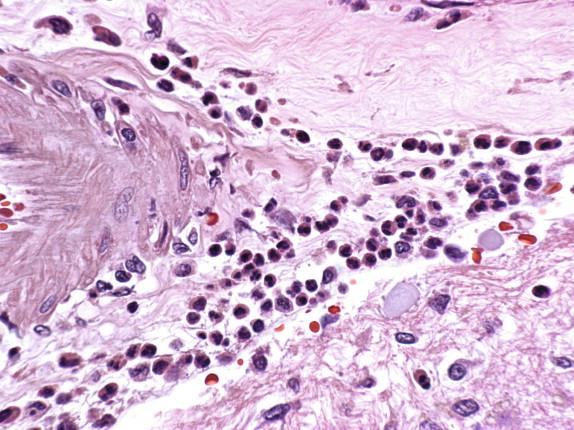
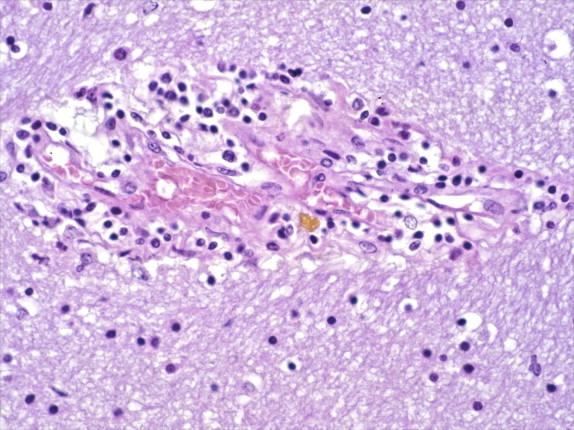
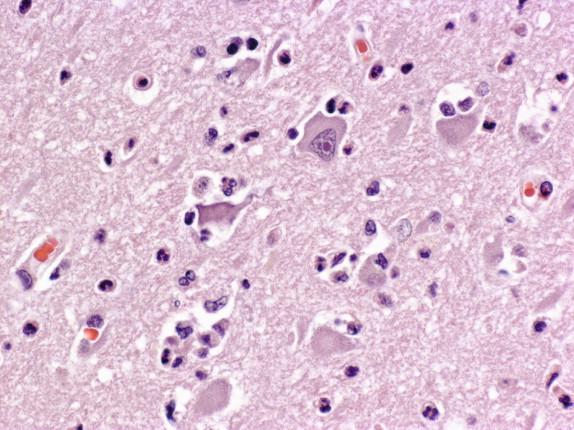
PCR assays have been developed for the identification of EEE virus infections. They can be applied on fresh tissue samples, as well as formalin-fixed paraffin-embedded tissues. Immunohistochemical assay (IHC) can demonstrate viral antigens in neurons, neuronal processes, and areas of parenchymal necrosis ( Figure 7-18 A, B).
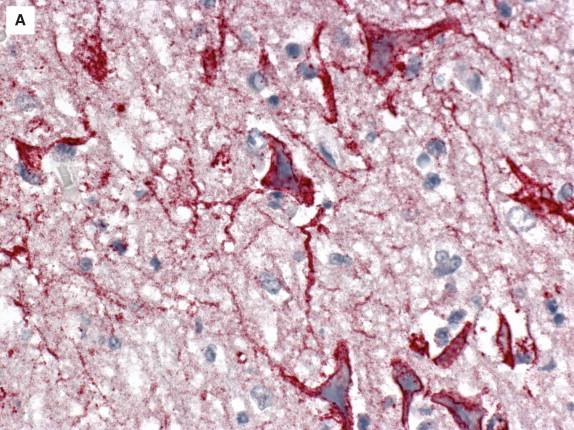
The clinical differential diagnosis includes encephalitides caused by viruses listed in Table 7-1 , as well as by a wide spectrum of parasitic, fungal, bacterial, and rickettsial organisms. Histopathologic examination can help shorten the long list of differential diagnoses and suggest if the infection is more consistent with encephalitis caused by viruses or other microorganisms.
EEE is usually associated with a high case fatality rate and severe sequelae among survivors. The case fatality rate is 30% to 40% in more recent studies, with the highest rates in children and the elderly. Sequelae, including seizures, paralysis, and mental retardation, are common. A significant proportion (35% to 80%) of survivors, particularly young children, develop long-term neurologic impairment. There is no effective antiviral drug or specific treatment for EEE.
Like EEE, the WEE virus is also an Alphavirus . In the summer of 1930, an epizootic outbreak occurred in the San Joaquin Valley of California, causing an estimated 6000 cases of equine encephalitis. During this outbreak, WEE virus was isolated from the brains of two affected horses and was subsequently recovered from the brain of a child with fatal encephalitis in 1938. The WEE virus is distributed primarily in the U.S. states west of the Mississippi River, but it has also been reported to cause outbreaks in Midwestern states and as far east as New Jersey. In North America, WEE virus is maintained in an endemic cycle involving domestic and passerine birds and Culex tarsalis , a mosquito adapted to irrigated agricultural areas. Similar to EEE, WEE occurs in summertime; both horses and humans are susceptible to infection, which frequently manifests as encephalitis. The number of WEE cases has steadily declined since the mid-1980s. Although subclinical human infection is common in endemic areas, the attack rates are much higher in young children than in other age groups.
The disease spectrum may range from mild, nonspecific febrile illness to severe encephalitis. In the majority of adult cases, the prodromal phase usually subsides spontaneously with no neurologic complications. When CNS involvement occurs, WEE virus causes encephalitis with signs and symptoms similar to those of EEE. WEE infection is heralded by a short prodromal phase lasting 1 to 4 days with fever and headache and may progress to restlessness, tremor, irritability, nuchal rigidity, photophobia, altered mental status, and paralysis.
Laboratory studies of CSF reveal elevated white blood cells, red blood cells, and protein, but the cell counts are usually lower than those noted for EEE. Glucose is normal. Laboratory diagnosis of WEE was usually established by serologic tests.
Encephalitis caused by western equine encephalitis virus, a mosquito-borne virus in the genus Alphavirus, family Togaviridae.
The WEE virus is distributed primarily in the U.S. states west of the Mississippi River.
It caused sporadic outbreaks in Midwestern states and as far east as New Jersey.
In North America, WEE virus is maintained in an endemic cycle involving domestic and passerine birds and Culex tarsalis , a mosquito adapted to irrigated agricultural areas.
WEE occurs in summertime; both horses and humans are susceptible to infection, which frequently manifests as encephalitis.
The numbers of WEE cases have steadily declined since the mid-1980s.
Although subclinical human infection is common in endemic areas, the attack rates are much higher in young children than in other age groups.
The disease spectrum may range from mild, nonspecific febrile illness to severe encephalitis.
In majority of adult cases, the prodromal phase usually subsides spontaneously with no neurologic complications.
When CNS involvement occurs, signs and symptoms are similar to those of EEE.
WEE infection usually has a short prodromal phase lasting 1 to 4 days with fever and headache and may progress to restlessness, tremor, irritability, nuchal rigidity, photophobia, altered mental status, and paralysis.
The case fatality rate of WEE at 3% is much lower than that for EEE.
As many as 60% of WEE survivors have permanent neurologic damage, especially infants less than 1 year of age.
There is no effective antiviral drug or specific treatment.
Similar to EEE, WEE can cause inflammation throughout the brain and spinal cord. The brain may be edematous with areas of necrosis or hemorrhage.
Histopathologic findings of acute WEE are limited to a few case reports and animal experiment subjects. In general, the findings are similar to those seen in EEE, including leptomeningitis, parenchymal necrosis, neuronal necrosis, neuronophagia, glial nodules, gliosis, and perivascular cuffing with polymorphonuclear and mononuclear leukocytes. Inflammation can be accompanied by endothelial swelling and hemorrhages. Lesions are found primarily in the basal ganglia, brainstem, cerebellum, cerebral cortex, and spinal cord. In addition, focal areas of demyelination, particularly in the subcortical white matter and basal ganglia, have been observed.
Similar to EEE, the CSF is usually abnormal with increased pressure, white cell counts, and protein, as well as a low or normal glucose level.
Serologic testing remains the most commonly used method to confirm the diagnosis.
Gross findings are usually nonspecific.
Histopathologic findings are similar to those seen in EEE, including leptomeningitis, parenchymal necrosis, neuronal necrosis, neuronophagia, glial nodules, gliosis, and perivascular cuffing with polymorphonuclear and mononuclear leukocytes.
Inflammation can be accompanied by endothelial swelling and hemorrhages.
Lesions are found primarily in the basal ganglia, brainstem, cerebellum, cerebral cortex, and spinal cord.
In addition, focal areas of demyelination, particularly in the subcortical white matter and basal ganglia, may be seen.
IHC can demonstrate viral antigens in neurons, neuronal processes, and areas of parenchymal necrosis similar to those findings in EEE.
IHC can demonstrate viral antigens in neurons, neuronal processes, and areas of parenchymal necrosis similar to those findings in EEE. PCR assays have been developed for the identification of WEE virus infections in fresh tissue samples and formalin-fixed paraffin-embedded tissues.
The clinical differential diagnosis includes encephalitides caused by viruses listed in Table 7-1 , as well as by a wide spectrum of parasitic, fungal, bacterial, and rickettsial organisms. Histopathologic examination can help shorten the long list of differential diagnoses and suggest if the infection is more consistent with encephalitis caused by viruses or other microorganisms.
The case fatality rate of WEE at 3% is much lower than EEE. As many as 60% of WEE survivors have permanent neurologic damage; this is especially true for infants younger than 1 year of age. There is no effective antiviral drug or specific treatment for WEE.
VEE virus was first isolated from the brains of encephalitic horses during an outbreak of equine encephalitis in Colombia and Venezuela in 1936. This virus was recognized as being antigenically distinct from EEE and WEE viruses and became the third encephalitic Alphavirus identified in the Americas. Subsequently, VEE-related viruses were isolated and identified in many locations in South America, Central America, the Caribbean islands, and the southern regions of the United States. Currently, there are six subtypes in the VEE virus complex. VEE virus infections have been associated with numerous equine and human cases in these regions. Epizootic strains of VEE virus have the special capacity to cause disease in horses and humans. At least 10 mosquito species have been identified as probable epidemic vectors. Typically, epizootics begin in areas of tropical forests during the rainy season. In the epizootic center, transmission usually continues until all horses are dead or immune. VEE epizootics have occurred at approximately 10- to 20-year intervals; they may be spread to contiguous areas or may be localized. Severe human disease with encephalitis is most commonly seen in children. Although VEE virus can be isolated from throat washings and is infectious by the aerosol route, person-to-person transmission has not been well documented.
In contrast to epizootic strains, enzootic strains of VEE virus are mainly sustained by their mosquito vectors and rodents that thrive in tropical and subtropical swamps and forests. Humans living in these areas demonstrate a high prevalence of antibody associated mostly with undiagnosed mild febrile illnesses; only sporadic cases of encephalitis caused by these enzootic strains have been reported in Central America and Florida.
Clinically evident human infection can occur with both epizootic and enzootic VEE complex viruses. The most common clinical manifestation of epizootic VEE virus infection is a febrile illness with malaise after an incubation period of 1 to 6 days. Other nonspecific symptoms include chills, myalgia, and headache with or without photophobia. During epizootics, human attack rates vary widely, and neurologic symptoms usually appear 4 to 10 days after the onset of illness with headache and vomiting as the most common initial symptoms followed by seizures, paresis, mental status changes, stupor, and coma. All ages and both sexes are equally susceptible to infection; however, disease manifestations vary with age. Although nearly all human infections with VEE virus are believed to be symptomatic, only a small percentage of natural cases of VEE (0.5% of adults and up to 4% of children) show apparent CNS involvement. Individuals under the age of 15 are more likely to develop fulminant disease with reticuloendothelial infection, lymphoid depletion, and encephalitis. Individuals over 50 are also prone to develop encephalitis, but most patients make a full recovery.
Laboratory studies characteristically reveal lymphopenia, sometimes accompanied by neutropenia and mild thrombocytopenia within a day or two of onset. Liver function abnormalities, such as elevated serum aspartate aminotransferase and lactate dehydrogenase enzymes, are frequently observed. CSF examination reveals a few hundred lymphocytes. Diagnosis can be made by documenting the presence of IgM antibody or a rise in IgG antibody.
Encephalitis caused by Venezuelan equine encephalitis virus, a mosquito-borne virus in the genus Alphavirus, family Togaviridae.
VEE virus is antigenically distinct from EEE and WEE viruses.
There are six subtypes in the VEE virus complex.
Epizootic strains of VEE virus have the special capacity to cause disease in horses and humans.
Typically, epizootics begin in areas of tropical forest during the rainy season.
In the epizootic center, transmission usually continues until all horses are dead or immune.
Although VEE virus can be isolated from throat washings and is infectious by the aerosol route, person-to-person transmission has not been well documented.
In contrast to epizootic strains, enzootic strains of VEE virus are mainly sustained by their mosquito vectors and rodents that thrive in tropical and subtropical swamps and forests.
Horses are not amplifying hosts for enzootic strains of VEE virus.
Humans living in areas with enzootic strains of VEE virus demonstrate a high prevalence of antibody associated mostly with undiagnosed mild febrile illnesses.
Only sporadic cases of encephalitis caused by these enzootic strains have been reported in Central America and Florida.
Clinically evident human infection can occur with both epizootic and enzootic VEE complex viruses.
The most common clinical manifestation of epizootic VEE virus infection is a febrile illness with malaise after an incubation period of 1 to 6 days.
Other nonspecific symptoms include chills, myalgia, and headache with or without photophobia.
During epizootics, human attack rates vary widely, and neurologic symptoms usually appear 4 to 10 days after the onset of illness with headache and vomiting as the most common initial symptoms followed by seizures, paresis, mental status changes, stupor, and coma.
All ages and both sexes are equally susceptible to infection; however, disease manifestations vary with age, and severe cases with encephalitis are most commonly seen in children.
Only a few natural cases of VEE (0.5% of adults and up to 4% of children) show apparent CNS involvement.
Individuals under the age of 15 are more likely to develop fulminant disease with reticuloendothelial infection, lymphoid depletion, and encephalitis.
Individuals over 50 are also prone to develop encephalitis, but most patients recover.
The overall case fatality rate is less than 1% but becomes much higher in cases that progress to encephalitis.
Mortality rates in neurologic cases are as high as 35% in children and 10% in adults.
Long-term neurologic deficits, abortions, and teratogenic effects have also been reported due to VEE virus infection.
There is no effective antiviral drug or specific treatment.
Gross findings in affected humans include cerebral edema; however, the gross pathology of human cases of VEE has not been well described.
Histopathologic examination of tissue samples from limited fatal human cases shows encephalitis, myocarditis, focal centrilobular hepatic necrosis with inflammation, and generalized lymphoid depletion. Lesions in the brain are found primarily in the temporal cortex and basal ganglia with histopathologic changes consisting of perivascular cuffing and glial nodules. Meningeal infiltrates are composed of lymphocytes, mononuclear cells, and neutrophils. Vasculitis and perivascular hemorrhage are observed in a minority of cases. Although cerebritis is a relatively common finding in these cases, the overall distribution of histologic lesions in the brain has not been thoroughly documented. VEE virus infection can cause congenital infection, and the infected neonates show severe neurologic damage with widespread necrosis, hemorrhage, and hypoplasia of brain.
Laboratory studies characteristically reveal lymphopenia, sometimes accompanied by neutropenia and mild thrombocytopenia within a day or two of onset.
Liver function abnormalities, such as elevated serum aspartate aminotransferase and lactate dehydrogenase enzymes, are frequently observed.
CSF examination reveals increased pressure, protein, and a few hundred lymphocytes.
Serologic testing is the most commonly used method to confirm the diagnosis.
Histopathologic features show encephalitis, myocarditis, focal centrilobular hepatic necrosis with inflammation, and generalized lymphoid depletion.
Lesions in the brain are found primarily in the temporal cortex and basal ganglia with histopathologic changes consisting of perivascular cuffing and glial nodules.
Meningeal infiltrates are composed of lymphocytes, mononuclear cells, and neutrophils.
Vasculitis and perivascular hemorrhage are observed in a minority of cases.
VEE virus can cause congenital infection, and the infected neonates show severe neurologic damage with widespread necrosis, hemorrhage, and hypoplasia resulting in hydranencephaly.
Specific RT-PCR assays were developed for the detection of VEE virus, which may be useful for diagnosis and surveillance in endemic areas.
The algorithm of differential diagnosis is similar to other encephalitides; however, the involvement of other non-CNS organs should raise the index of suspicion for VEE, especially in endemic areas.
The overall case fatality rate is less than 1%, but it becomes much higher in cases that progress to encephalitis. Mortality rates in neurologic cases are as high as 35% in children and 10% in adults. Long-term neurologic deficits, abortions, in teratogenic effects have also been reported due to the VEE virus. There is no effective antiviral drug or specific treatment for VEE.
West Nile virus (WNV) is a member of the JE serocomplex group Flavivirus and is antigenically related to SLE and JE viruses. Electron microscopy of WNV reveals a 45- to 50-nm virion covered with a relatively smooth protein surface ( Figure 7-19 ). WNV was first isolated from the blood of a febrile patient in the West Nile province of Uganda in 1937 and is considered a common childhood infection in Africa. Before 1999, outbreaks of human WNE were primarily confined to eastern Africa, the Middle East, Eastern Europe, west Asia, and Australia. In September of 1999 in the northeastern United States, human West Nile virus infections appeared for the first time in the Western Hemisphere. More widespread activities were observed in subsequent years and a dramatic increase in virus spread was seen across the United States, as well as in some Canadian provinces. The epidemics of WNV in 2002 and 2003 were the largest outbreaks of neuroinvasive viral infections ever reported in the Western Hemisphere. Since its introduction in 1999, the ecology, epidemiology, virology, and pathology of North American WNV have been studied extensively. The many competent mosquito vectors and diverse susceptible vertebrate hosts, as well as the virulence of the North American WNV strain, may have contributed to the rapid spread and establishment of the virus in North America. WNV infection is now the most common cause of epidemic viral encephalitis in the United States. This strain has been shown to be highly virulent in birds, and the higher viremia in this vertebrate host may also contribute to more active transmission.
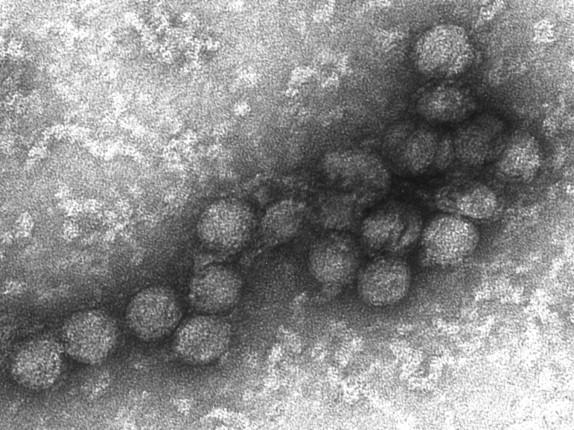
WNV is transmitted in an enzootic cycle between mosquitoes, primarily Culex spp., and birds, particularly water birds and birds in the corvid family. Humans and horses become infected through the bite of an infected mosquito, but neither serves as an amplifying host. In addition, WNV has caused infections in more than 30 species of nonavian vertebrate hosts, including felines, canines, ungulates, rodents, bats, sea mammals, and alligators. Clinical illness leading to death can result from infections in any of these hosts. However, it is not known whether any nonavian vertebrate hosts play a role in transmission or maintenance of WNV. Most cases occur in the mid- to late summer in temperate regions, corresponding to the transmission activity of the mosquito vector. Other transmission routes among humans via blood transfusions, breast milk, or organ transplants have also been documented.
After exposure to the WNE virus, the incubation period usually ranges from 2 to 6 days but may extend to 14 days and can be as long as 21 days in patients following organ transplantation. Similar to other JE serocomplex group Flaviviruses , the majority of WNV infections are asymptomatic, with approximately one in five patients experiencing a mild illness characterized by acute onset of fever, headache, fatigue, malaise, arthralgia, myalgia, gastrointestinal symptoms, and a transient macular rash on the trunk and extremities. Generally, symptoms resolve completely within 2 months; however, long-term effects and persistent infection have been reported, and it is an active area of research. Neuroinvasive disease, including encephalitis, meningitis, paralysis, and seizures, develops in less than 1% of WNV infections. Immunosuppressed and elderly individuals are at a much higher risk for the neuroinvasive disease. Patients with neurologic disease typically have a febrile prodrome of 1 to 7 days, followed by neck stiffness, headache, muscle weakness, gastrointestinal symptoms, convulsions, paralysis, and altered mental status. Prominent muscle weakness and flaccid paralysis have been particularly documented in clinical illness in the United States, suggesting an axonal polyneuropathy or myelitis in addition to encephalitis. Weakness may be generalized or of a lower motor neuron type associated with hypotonia and areflexia with preserved sensation. Cranial neuropathies, most commonly involving unilateral or bilateral peripheral facial palsy, occur in approximately 20%. Other non-CNS organs, such as heart, pancreas, and liver, may also be infected by WNV, causing myocarditis, pancreatitis, and fulminant hepatitis, respectively.
Become a Clinical Tree membership for Full access and enjoy Unlimited articles
If you are a member. Log in here